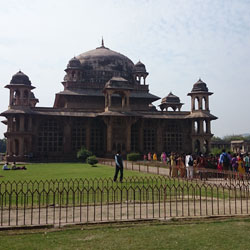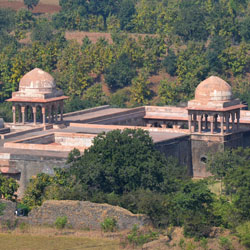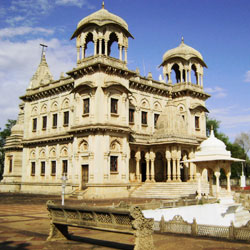
- Home
- Travel Packages
- Top Destination
-
Travel Attraction
By Category
Top Attraction

- Travel Agents
- Car Rentals
- Hotels

A pillar of Hindustani classical music, the great Tansen, the musician extraordinaire of Akbar's Court, lies buried in Gwalior. The beautiful garden, in which the tomb is located, is the venue of the annual music festival held during November-December. Distinct personalities from abroad also visit and rejoice music. Gwalior is also renowned for the tomb of Tansen, the musician extraordinaire of Akbar's Court (one of his 'nau ratan', nine jewels). Gwalior retains a strong musical tradition, and continues to be an influential force in Hindustani classical music. Tansen, an exponent of the Dhrupad style, went on to evolve the Gwalior Gharana style, whose contemporary exponent is the globally renowned Sarod player, Amjad Ali Khan. The memorial to this great musician has a pristine simplicity about it, built in the early Moghul architectural style. More than a monument, the tomb is part of Gwalior's living cultural heritage. Leading musicians of the country gather here to give performances during the festival.
Explore More
If you are in this fabulous city of Madhya Pradesh, you must have a plan visiting the Gwalior Fort. For your information, the tomb is only 1 km away from the fort. Apart from Mohammed Ghaus, Tansen is also buried here. Besides its historical importance, the tomb is also famous for its great architecture. You will get a memorable visit here as it is counted among the most protruding sightseeing attractions of Gwalior, Madhya Pradesh. Visitor Information: The tomb of Mohammed Ghaus, Gwalior is one of the protuberant pilgrimages for both Hindu and Muslim religious people. History: The construction of the tomb of Mohammed Ghaus was done in 16th century AD when Mughal Samrat Babar was the ruler here. Afghan Prince Ghaus Mohammed later turned into a Sufi saint. According to the legend, in 1526 CE, he assisted Babar to conquer the Gwalior Fort. Apart from this, the Sufi saint has many other influences over the Mughal emperors – Babar and his son Humayun. Architecture: As Mohammed Ghaus was alive during the Mughal reign, his tomb structure contains typical Mughal architecture. It is standing on the hexagonal pillars at all of its four corners. The building of the entire tomb is square-shaped. There is another square-shaped dome on top of it that is adorned with ceramic tiles of blue color. There are kiosks too inside the dome which are also hexagonal-shaped and their corners are together slopped eaves which are projected from the exterior. The exterior and interior of the tomb walls include latticework and sophisticated carvings. Festival: The tomb of Tansen is situated surrounded by green gardens and carries the signature style of the Mughal architecture. It serves as one of the existing cultural heritage of the city. Every year during the month of November- December, Tansen Music Festival is organized here which s a national level program and thus various great musicians from every part of the nation come to attend the festival. A nice and serene atmosphere is created with their influential music performances. Best Time to Visit: The best time to visit the Tomb of Mohammed Ghaus and Tansen is during November- February. This time, the weather remains pleasant here. You can visit the tombs between 9 AM and 5 PM every day. How to Reach? • By air – You need to board a flight for Rajmata Vijaya Raje Scindia Airport, Gwalior. It is 13 km away from the destination. • By train – Simply board a train to reach Gwalior Junction. It is well connected with railways to many parts of the country. • By bus – Nearest bus station is Gwalior bus station. Avail any private or public bus services to reach here from any parts of India. Nearby Attractions: The Tomb of Tansen or the memorial of Tansen is situated pretty close to the tomb of Mohammed Ghaus, Gwalior. Tansen was one of the nine jewels’ in the court of Akbar who was a popular musician of that era. In fact, he is known as one of the most influential personalities in the tradition of North India and also in Hindustani classical music. He is best remembered and respected in the world of classical music for his epic compositions of Dhrupad which has created a range of new sagas. He also wrote two larger-than-life books on music including Sangita Sara and Sri Ganesh Stotra. Mohammed Ghaus was his guru and thus he also got buried close to his tomb. Undoubtedly, these burial sites are a great piece of architecture. Plan your trip now!
Explore More
Chhatris or cenotaphs erected in memory of the Holkar rulers and their families are incomparable examples of Maratha architecture and sculpture. These Chhatris were the temples where Holkars used to attend Poojas. The largest and the most impressive is that of Malhar Rao Holkar I lavishly decorated with frescoes while that of Rani Ahilyabai is also important. As time passed, they were neglected and shopkeepers and hawkers encroached the land around them. But recently, District Administration forcefully got them moved from the place and secured back the significance and beauty. Thus they got back historic significance and glory. On the banks of River Khan, it has seven memorials of the Holkar kings but the inner sanctums are locked.
Explore More
The palace of Baz Bahadur now belongs to the Hill Fort complex, Mandu. On your trip to Mandu, you will surely not want to miss an opportunity of visiting the charm of this palace. The entire city of Mandu is filled with constructions which are having Islamic architectural style. This is because Muslim rulers have dominated the place for many decades. Visitor Information: Entry to the Baz Bahadur’s Palace is not free for the tourists. The charges are as below - • Indian tourists – 5 Rs • Foreigner tourists – 100 Rs • Video camera – 25 Rs Traveler Tips: Though the palace is open from 7 AM to 7 PM, you can best enjoy visiting the palace is from sunrise to sunset. Daytime is preferable for visiting as there is no special lighting facility available for the dusk. So, plan your visit accordingly. History: You must be thinking who was Baz Bahadur? He was the sultan of this city from 1555 to 1561. It was during his reign, Mandu reached its highest grandeur. But he has built the palace much before he became a king i.e. in 1509. This beautiful edifice was built on the hill and beneath lies the Rewa Kund, which is used as a water supply source. Architecture: The Baz Bahadur's Palace, Mandu shows a great example of ancient rock architecture of the 5th – 6th centuries. The overall architecture of this monument reflects Islamic as well as Rajput style. The entrance of the monument has 40 big stair steps to climb but having landings at intervals. A passage is there on both sides of the royal gateway, which has lined up guard quarters. Then comes the main entrance to the palace. Visitors may see a range of hallways, courtrooms, etc. while entering through it. A gorgeous cistern is there at the center of the entrance. Apart from this huge hall, you can spot a platform having octagonally shaped there. It was used then to enjoy the view of the outside lush green garden. On the terrace of the palace, you can find a baradari or recreation area. This place was used to get a magnificent view of the surrounding of the palace. Best Time to Visit: Mandu is pleasant visiting from November to February. You can visit the palace anytime a day between 7 AM to 7 PM. But the most recommended time to visit is during sunlight i.e. 8 AM to 5 PM. You will be required at least half an hour to enjoy the entire architecture. How to Reach? By road – Mandu, Madhya Pradesh is counted among one of the desired destinations for most of the tour of India, hence it has a good road network. Manu is reachable from most of the major cities and towns in the country. Regular bus service is available between mandu and Indore and Mandu and Bhopal. By air – The nearest airport is Indore airport which is 100 km away from Mandu. By train – Railways are also a good travel option for being here. You need to reach Ratlam. Otherwise, you can also ride through the branch root of the Indore railway; it is 99 km away from Mandu. Nearby Attractions: When you are at Mandu, you can also enjoy visiting – • Jahaz Mahal • Rani Roopmati’s Pavilion • Jama Masjid • Hindola Mahal • Champa Baoli and Hammam Some popular restaurants nearby include – • Ganga Jamuna Restaurant • Indore Dhaba • Badhri Dhaba • Shivani Restaurant • Baba Ka Dhaba, etc.
Explore More
Situated at a distance of 121 km away from Gwalior, Shivpuri is a small town of Madhya Pradesh. The place is a stunning amalgamation of Hindu and Mughal cultures and has been a residence of the royalty in its glorious past. This place is also well known for the chhatris or chhatri monuments. The chhatris are a visual treat that speaks about the rich heritage of India. The chhatri monuments in Shivpuri are a perfect mix of Mughal and Hindu architecture. These beautiful structures were set in a Mughal garden and were made under the reign of the Scindia clan of Gwalior. The entire monument is highly admired for its architectural grandeur. Surrounded by huge trees, dense shrubs, and green orchards, chhatris in Shivpuri look remarkably beautiful. Visitors are sure to be highly impressed by them. The garden in which the chhatris are set is very fascinating. There are various gorgeous flower plants within the complex and pathways are made, which intersect the garden. The garden is bordered with ornamental balustrades and Victorian lamps are installed to illuminate it. History Of Chhatri Monument, Shivpuri: Chhatris in Shivpuri are the tombs of late Scindia rulers Maharaja Madhav Rao Scindia and Maharani Sakhya Raje Scindia. Since Shivpuri was the summer capital of Scindia rulers, chhatris have been erected here. Architecture Of Chhatri Monument, Shivpuri: Made up of marble, these chhatris are elegantly decorated. This marble tribute to Madhav Rao Scindia is specifically impressive as it was inlaid with many semi-precious gems and embroidered with delicate screens that were reminiscent of the Taj Mahal. It is also believed to be the last example of pietra dura inlay work executed on such a great scale. The architectural style of these chhatris is a seamless blend of Islamic and Hindu influences with shikhara-type spires and Mughal and Rajput pavilions. Solid silver doors of the chhatris lead visitors into a spacious hall where the seams of the pillars and the roof were ornamented with pure gold. The chhatris of Madhav Rao Scindia and Maharani Sakhya Raje Scindia stand facing each other and there is a water tank in between these two structures. Tucked away in one section of the gardens here, there is a small memorial constructed in the same pietra dura inlay style. This memorial is dedicated to the Madhav Rao Scindia II who died in an air crash. Best Time To Visit Here: As Shivpuri is a popular tourist destination of Madhya Pradesh, it is frequented by tourists throughout the year. During summers, the temperature in Shivpuri soars up to 40 degrees Celsius and traveling throughout the city during this time will be unfavorable and exhausting. The winters in Shivpuri are very pleasant and the average temperature remains at 11 degrees Celsius which is perfect to visit Chhatri Monument and other places of interest in and around the place. So, the best time to visit Chhatri Monument in Shivpuri is from the months of December to February. Shivpuri experiences heavy rainfall during the monsoon season, so one should avoid visiting Shivpuri in this period. How To Reach Here: As Shivpuri has well connectivity with the major towns and cities of Madhya Pradesh, there is no problem in reaching the place. Once you reach Shivpuri, you can easily get a bus, taxi, cab or auto-rickshaw to reach Chhatri Monument. • By Air- If you are interested in traveling by air, take a flight till Gwalior and then reach Shivpuri by taking a bus or hiring a car. Rajmata Vijaya Raje Scindia Air Terminal (Gwalior Airport) is the nearest airdrome and it will take 2 hours 48 minutes from the airport to reach the destination. The airport is at a distance of 125.6 Km from Shivpuri. • By Train- Shivpuri has rail links with major other cities like Bhopal (300 Km), Indore (400 Km), Delhi (400 Km). People can also take a train till Gwalior and then reach Shivpuri by bus or taxi. • By Road- Shivpuri connects several important cities by road like Delhi (400 Km), Indore (400 Km), Bhopal (300 Km), Jhansi (100 Km), and many more. Nearby Attractions Here: While visiting the Chhatri monument in Shivpuri, visitors can explore some other attractions here like Sakhya Sagar Lake, Survaya ki Garhi, Pawa Waterfalls, Shivpuri District Museum, Madikheda Dam, Bhadiya Kund, Karera Bird Sanctuary, Madhav Vilas Palace, Narwar Fort, and many more.
Explore More5D - 4N Madhya Pradesh Tour Package
5 Days/ 4 Night
Bhopal - Indore - Ujjain - Sanchi
Ujjain - Mahakaaleshwar - Omkareshwar Jyotirlinga Tour Package
3 Days/ 2 Night
Indore
Madhya Pradesh Tour Package 5D - 4N
5 Days/ 4 Night
Bhopal - Indore - Ujjain - Sanchi
Mystic Khajuraho Getaway from Lucknow
3 Days/ 2 Night
Khajuraho